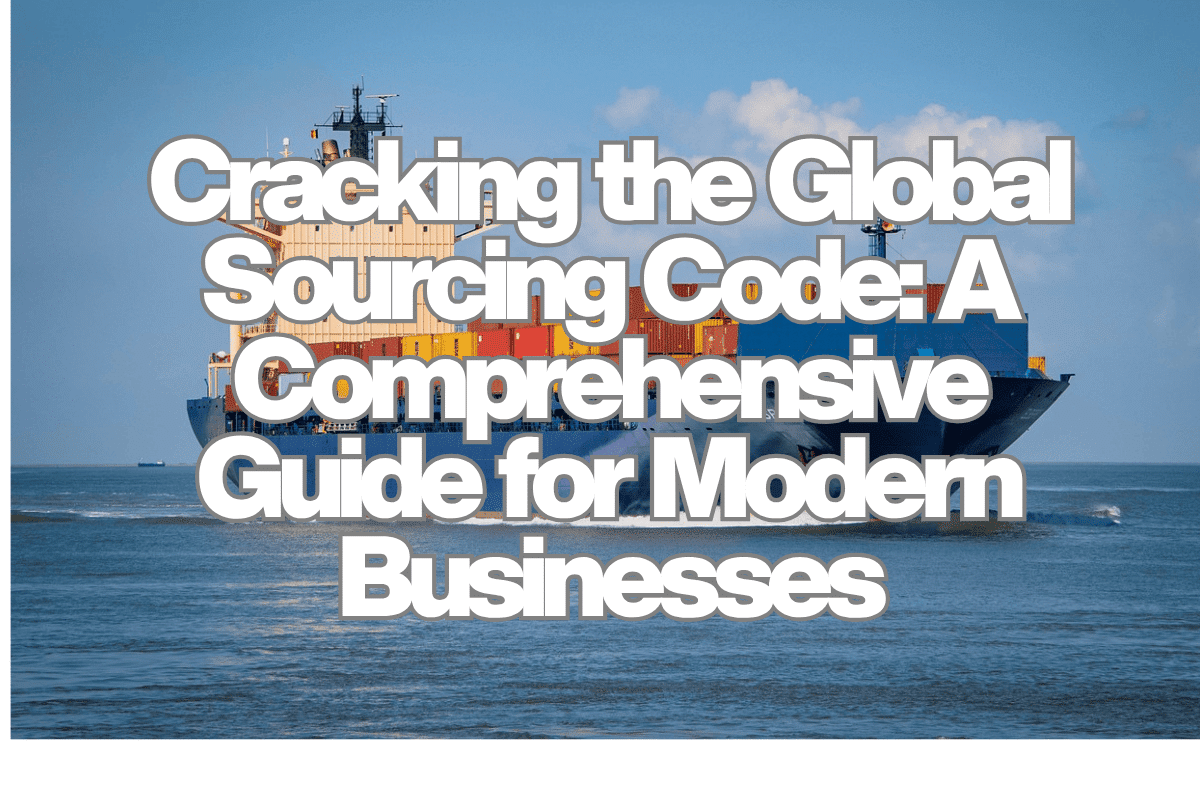In today’s interconnected world, global sourcing has become a cornerstone of successful business strategies. While platforms like Alibaba have made it easier to connect with suppliers, true global sourcing requires a more nuanced approach.
Read on as we will explore the essential elements of effective global sourcing, from strategic research and niche market identification to building strong supplier relationships and leveraging technology. We’ll also delve into the complexities of legal and logistical considerations, payment strategies, and quality control, providing you with a roadmap to navigate the overseas labyrinth successfully.
Table of Contents
- Beyond Alibaba: Strategic Research and Niche Market Identification
- The “Trust Triad”: Building Rapport and Vetting Suppliers
- Leveraging AI and Data Analytics for Product Discovery
- Navigating the Overseas Labyrinth: Legal & Logistics
- Payment Power Plays & Financial Fortunes
- Quality Control from Afar: Your Eyes on the Ground
- Mondoro’s Inspection Policies
- Scaling Your Sourcing Success: Growth Strategies
- The Future of Global Sourcing: Trends and Innovations
- Deep Dive Podcast
- Related Content
Beyond Alibaba: Strategic Research and Niche Market Identification
The first step in effective global sourcing is conducting thorough research. While Alibaba is a well-known platform for finding suppliers, relying solely on it can limit your options and expose you to potential risks. True global sourcing starts with strategic research that identifies niche markets and suppliers that align with your business needs.
Understanding Niche Markets
Niche markets are specialized segments of a larger market, often characterized by unique demands and preferences. By identifying these markets, businesses can source products that meet specific customer needs, allowing them to differentiate themselves from competitors. For instance, if you’re in the eco-friendly product sector, researching suppliers who specialize in sustainable materials and practices can give you a competitive edge.
Utilizing Market Research Tools
To effectively identify niche markets, leverage market research tools and databases. Platforms like Statista, IBISWorld, and Euromonitor provide valuable insights into market trends, consumer behavior, and emerging opportunities. Additionally, attending industry trade shows and exhibitions can help you discover new suppliers and gain firsthand knowledge of market dynamics.

The “Trust Triad”: Building Rapport and Vetting Suppliers
Once you’ve identified potential suppliers, the next step is to build rapport and vet them thoroughly. Establishing trust is crucial in international sourcing, where cultural differences and communication barriers can lead to misunderstandings.
Building Rapport
Building rapport with overseas suppliers involves establishing open lines of communication and fostering mutual respect. Regular video calls, emails, and even in-person visits can help strengthen relationships. By showing genuine interest in their operations and understanding their challenges, you can create a partnership based on trust.
Vetting Suppliers
Vetting suppliers is essential to avoid costly pitfalls. Start by checking their business licenses and certifications to ensure they comply with industry standards. Request references from other clients and conduct background checks to verify their reputation. Additionally, consider visiting their facilities, if possible, to assess their production capabilities and quality control processes.
Leveraging AI and Data Analytics for Product Discovery
In the age of digital transformation, leveraging AI and data analytics can significantly enhance your global sourcing strategy. These technologies enable hyper-targeted product discovery and trend forecasting, allowing businesses to stay ahead of the competition.
Hyper-Targeted Product Discovery
AI-driven platforms can analyze vast amounts of data to identify emerging trends and consumer preferences in international markets. By utilizing these insights, businesses can source products that align with current demands, reducing the risk of overstocking outdated inventory.
Trend Forecasting
Data analytics also plays a crucial role in trend forecasting. By analyzing historical data and market signals, businesses can anticipate future trends and adjust their sourcing strategies accordingly. This proactive approach allows companies to remain agile and responsive to changing market conditions.

Navigating the Overseas Labyrinth: Legal & Logistics
Global sourcing involves navigating a complex landscape of legal and logistical challenges. Understanding these intricacies is essential for successful international transactions.
Incoterms Simplified
Incoterms (International Commercial Terms) define the responsibilities of buyers and sellers in international shipping. Familiarizing yourself with these terms is crucial to understanding who pays for what and when. Common Incoterms include FOB (Free On Board), CIF (Cost Insurance and Freight), and DDP (Delivered Duty Paid). Each term specifies the point at which ownership and risk transfer from the seller to the buyer, impacting pricing and liability.
Customs & Compliance in 2025
As global trade evolves, staying ahead of customs regulations and compliance requirements is essential. In 2025, businesses will face new tariffs and import documentation requirements. Keeping abreast of these changes will help you avoid delays and penalties. Consider working with customs brokers who can navigate these complexities on your behalf.
Smart Freight Forwarding
Optimizing shipping routes and consolidating shipments can lead to significant cost savings. Smart freight forwarding services utilize technology to streamline logistics, ensuring timely deliveries and efficient transport modes. By collaborating with experienced freight forwarders, businesses can enhance their supply chain efficiency and reduce shipping costs.
Payment Power Plays & Financial Fortunes
Managing payments in international sourcing requires careful planning and strategy. Understanding the various payment options and associated risks is crucial for protecting your financial interests.
Hedging Your Bets
Volatile exchange rates can significantly impact profit margins. Implementing hedging strategies, such as forward contracts or options, can help businesses manage currency risks. By locking in exchange rates, companies can protect their profits and ensure financial stability.
Unlocking Trade Finance
Exploring trade finance options, such as supply chain financing and export credit insurance, can facilitate smoother transactions. Supply chain financing allows businesses to optimize cash flow by extending payment terms with suppliers, while export credit insurance protects against non-payment risks in international trade.

Quality Control from Afar: Your Eyes on the Ground
Ensuring product quality is paramount in global sourcing. Implementing robust quality control measures can help avoid costly returns and maintain customer satisfaction.
Pre-Shipment Inspections
Conducting pre-shipment inspections is a non-negotiable step in the sourcing process. These inspections help identify defects and ensure that products meet specifications before they leave the supplier’s facility. Engaging third-party inspection services can provide an unbiased assessment of product quality.
Building Long-Term Supplier Relationships
Fostering open communication and continuous improvement is essential for maintaining consistent quality. Establishing long-term relationships with suppliers allows for collaboration on product development and quality enhancements, leading to mutual growth and success.
Mondoro’s Inspection Policies
At Mondoro, we prioritize quality and transparency in our sourcing process, which is why we implement two essential types of inspections to ensure that our clients receive only the best products.
1. Dupro Inspection
The first type of inspection we conduct is known as Dupro (During Production) inspection. This process allows us to check the goods while they are still in production. Our skilled inspectors are on-site to monitor the manufacturing process closely, ensuring that quality standards are met at every stage. By conducting inspections during production, we can identify and address any potential issues early, minimizing the risk of defects in the final product.
2. Final Detailed Inspection
The second type of inspection is the Final Detailed Inspection. This thorough examination occurs once the production is complete and before the goods are shipped. During this inspection, we meticulously check the finished products for quality, compliance with specifications, and overall presentation. Our team is dedicated to ensuring that every item meets our high standards and the expectations of our clients.
Comprehensive Coverage
At Mondoro, we are committed to being present throughout the entire inspection process. Typically, we evaluate close to 80% to 100% of all goods at some point during the inspection phases. This extensive oversight allows us to maintain rigorous quality control, ensuring that our clients receive products that are not only functional but also meet their aesthetic and operational requirements.
By implementing these thorough inspection policies, Mondoro guarantees that our clients can trust the quality of their sourced goods, fostering long-term relationships built on reliability and excellence.
Scaling Your Sourcing Success: Growth Strategies
As businesses grow, scaling their sourcing strategies becomes increasingly important. Diversifying the supply chain and mastering international returns are key components of this process.
Diversifying Your Supply Chain
Relying on a single supplier or geographical region can expose businesses to risks. Diversifying your supply chain by sourcing from multiple suppliers across different regions can mitigate these risks and enhance resilience. This strategy not only protects against disruptions but also allows businesses to tap into various markets and innovations.
Mastering Returns & Refunds Internationally
Establishing clear protocols for returns and refunds is essential for customer satisfaction. Understanding the legal and logistical aspects of international returns can help streamline this process. Consider implementing a return management system that facilitates efficient handling of returns while keeping customers informed throughout the process.
The Future of Global Sourcing: Trends and Innovations
As we look toward 2025 and beyond, several trends and innovations are shaping the future of global sourcing. Embracing these changes can position businesses for success in an ever-evolving landscape.
Blockchain Traceability
Blockchain technology offers unparalleled transparency and traceability in the supply chain. By utilizing blockchain, businesses can track products from their origin to the end consumer, ensuring authenticity and ethical sourcing. This technology can also streamline documentation processes, reducing administrative burdens.
Sustainable Practices
Sustainability is becoming increasingly important in global sourcing. Consumers are demanding eco-friendly products, and businesses must adapt to these preferences. Sourcing from suppliers who prioritize sustainable practices not only meets customer expectations but also contributes to a more responsible supply chain.
Automation in Sourcing
Automation is transforming the sourcing process, enabling businesses to streamline operations and enhance efficiency. From automated order processing to AI-driven supplier evaluations, technology is reshaping how companies manage their sourcing strategies. Embracing automation can lead to significant time and cost savings.
Cracking the global sourcing code requires a multifaceted approach that combines strategic research, relationship building, technological leverage, and robust quality control.
By understanding the complexities of international trade, businesses can navigate the overseas labyrinth effectively and unlock new opportunities for growth. As the landscape continues to evolve, staying informed about emerging trends and innovations will be crucial for sustained success in global sourcing. Embrace these strategies, and position your business for a prosperous future in the global marketplace.
Deep Dive Podcast
Discover more by listening to our podcast.
Find out more about how Mondoro can help you create, develop, and manufacture excellent home decor and furniture products – don’t hesitate to contact me, Anita. Check out my email by clicking here or become a part of our community and join our newsletter by clicking here.
Mondoro gives out a FREE Lookbook to anyone interested. You can receive a copy of our latest Lookbook by clicking here.
Listen to our Podcast called Global Trade Gal. You can find it on all major podcast platforms. Try out listening to one of our podcasts by clicking here.
Subscribe to our Mondoro Company Limited YouTube Channel with great videos and information by clicking here.
Related Content
Why Is It So Hard To Find Solid Wood Furniture Manufacturers?
Locating trustworthy solid wood furniture manufacturers can be an intricate endeavor for retailers and wholesalers. The task’s complexity is rooted in many factors related to solid wood furniture’s production and manufacturing procedures. Read on as we explore the complex task of the search for solid wood furniture manufacturers and how Mondoro can help you.
You can discover more by reading Why Is It So Hard To Find Solid Wood Furniture Manufacturers? by clicking here.
Is There A Market For Reclaimed Wood?
The reclaimed wood method minimizes waste, decreases the necessity for new lumber production, and conserves the timber’s innate allure and historical essence. Moreover, reclaimed wood comes in various types, each possessing unique attributes and rich narratives. Characteristics such as weather-worn patinas, nail indentations, saw traces, and various other blemishes enhance the charm of reclaimed wood, making it a treasured choice among designers and builders.
You can discover more by reading Is There A Market For Reclaimed Wood? by clicking here.
What Is Solid Wood vs. Engineered Wood?
Solid wood is cut down from the tree, cut into wood boards, and used for manufacturing. On the other hand, engineered wood is considered manmade as it is usually manufactured with wood chips, wood shavings, and an adhesive. Today the manufacturing of engineered wood is extremely technical.
You can discover more by reading our blog All About Teak Wood And Outdod? by clicking here.

